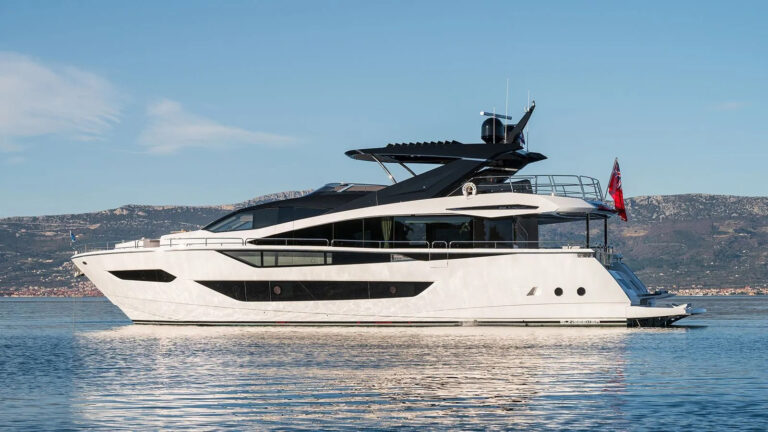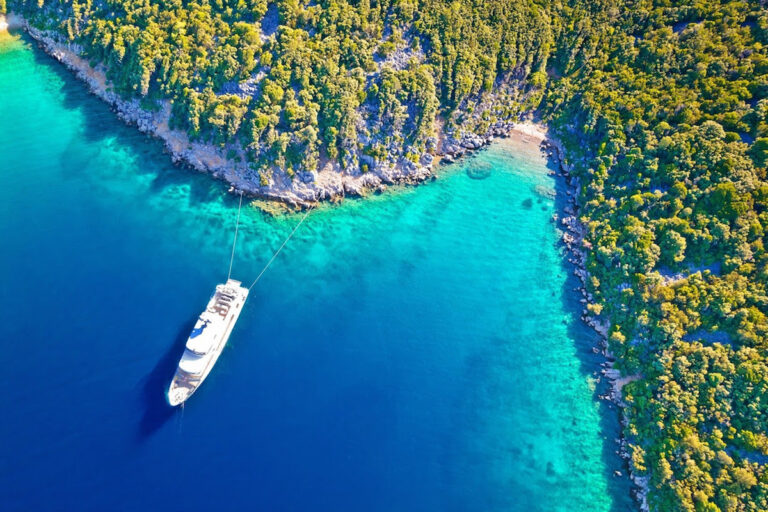Our course along the 81_W line had kept us 150 miles offshore of Colombia for most of the passage. But at the southern end the coastline juts out into the ocean, bringing that besieged country ever closer until, this morning at 0400, we were motoring only 105 miles offshore in waters reputed to be lively with smugglers as well as the occasional pirate. Sure enough, that’s when we saw the light.
Faint but steady, it appeared on the dark horizon directly off our bow, coming from the land. We checked radar to ascertain its distance from us, but the screen was blank. As we slowly converged (slowly the only speed we have), we altered course, yet the light continued to appear directly ahead. It looked like we were about to come face to face with our decision to press south to Ecuador. Marijuana, emeralds, guns, cocaine, immigrants what, we wondered, was the strange craft carrying-or in search of?
The situation actually felt ironic, given that we love the romance of the ancient trade routes. The Spice Route, the Silk Road, the Route de Rhum, even Route 66, to us, these are the stuff of myth. On the road ourselves now for almost a decade, we’d planned to leave Carricklee, our 45-foot Hardin ketch, in Nicaragua, Costa Rica or Panama while we spent the summer in the States. In the following spring, after a few months of exploring Central America, we would sail out to the Gal·pagos en route to the Marquesas and the beginning of a South Pacific adventure.
But as we’d continued our cruise southeast from Barillas Marina Club, El Salvador, we began to hear of a mythic route to an Ecuadorean Eden whispered around the nautical equivalent of the old campfire. VHF and sideband nets, supplemented by e-mails and tropical happy hours, praised two secure marinas-Puerto Amistad Marina, in Central Ecuador, and Puerto LucÌa Yacht Club, 120 miles farther south. The ultimate argument for storing a boat for several months at either marina hinged on climatic conditions: The wet season (our summer in the States) brings heavy rains and frequent electrical storms, both potentially damaging to boats. The sub-equatorial coast of Ecuador, on the other hand, receives scant annual rain, limiting the growth of mold and mildew and avoiding the frequent electrical storms north of the equator. Hurricanes and tsunamis were equally absent from the historical record at both places, so we agreed that the passage from Panama (June, “The Pearls of Panama) to Ecuador would be a small price to pay to gain this added security for Carricklee while we were away for four months.
Early on the first day, a large pod of spinner dolphins swam alongside, assuring us of a good passage. (We choose to give credence to good omens only.) When not bird-watching we spent a fair amount of each day and night watching out for the heavy ship traffic, 20 or more a night along Route 81_W-clearly the route of choice for ships transiting the Panama Canal. This kept us on our toes.
Even so, we were hardly prepared for our unidentified floating craft, now approaching fast. Finally, at 0550, a blip came up on the radar screen-only a mile away, much too close not to have been identifiable on radar earlier. Had they deployed stealth technology?
Again we diverted. Finally, with sunrise a few minutes shy of 0600, we had enough natural light to see the dark hull of the boat and to watch helplessly as it sped toward us. When a mere 300 yards or so away, all the lights on board abruptly went dark; moments later, it was racing alongside and past us–gone, as Patrick O’Brian’s Captain Jack Aubrey says, “like smoke and oakum. The next landfall, the Gal·pagos, lies 600 miles away. Her hull was painted black or dark blue; she flew no flag, had neither name nor identification numbers.
The final curiosity occurred when we had time to once again scan the radar screen: Blips appeared in some numbers immediately off to starboard and aft of the speedboat’s transom. Yet no boats were visible anywhere. Using the binoculars, we glimpsed briefly a dark, buoy-like object floating on the calm sea surface. Again our imaginations worked overtime: drugs or weapons dropped off in containers with radar reflectors? The boat we’d seen might have just dropped them off or was heading out to pick them up-until we’d bumbled onto the scene. We steered straight ahead, taking our curiosity with us. Not for a moment were we tempted to go back to check out the mysterious objects speckling the radar screen.
Two days later we safely made Ecuador, following in the wake of sailors who traded treasures up and down these sea roads for centuries before the arrival of the Spanish galleons in the 1500s. Today, thanks to two neighboring bays-BahÌa de Santa Elena and BahÌa de Car·quez-Ecuador has become another kind of major crossroads, as scores of contemporary pleasure boat sailors from throughout the Pacific find their way south, relying on word-of-mouth reports to guide them.
Instead of spice, gems and gold, today’s cruisers travel to enjoy 300 miles of coastline, challenging waves for surfing, a handful of inviting golden-sand beaches for swimming and lounging, and a baby’s handful of sheltered bays and coves for anchoring. Their pivotal locations, dry weather and marina facilities make both large bays ideal for exploring the history and culture of not only Ecuador and its possessions, the Gal·pagos, but of the neighboring countries, particularly Per·, Chile and Bolivia.
We arrived first in BahÌa de Santa Elena, the well-protected bay where Puerto LucÌa Yacht Club (PLYC) is located, ably directed by an English speaker on the radio and greeted by six yard workers on the fuel dock, who welcomed us warmly in Spanish and took our lines. Galo Ortiz, the manager of the hotel and the marina at PLYC, drove up in his golf cart to welcome us in fluent English, with George Stewart, a Canadian who landed here nine years ago for repairs to his boat after an unfortunate landfall in the Gal·pagos, stayed on, married an ecuatoriana, and now runs a well-managed boat repair facility. We met Suni and Charlie off Cosmos; from Arizona and California, they had already been in PLYC for many weeks readying to head out to sea, first to the Gal·pagos and then the Marquesas.
This turned out to be a fairly typical pattern: cruising sailors arriving at either port in Ecuador, then staying on for weeks and months. Indeed, upon our return in the fall after four months off, we found a thriving scene, including four singlehanding sailors (from Germany, Scotland, and two from the U.S.). A Finnish diving team exploring sunken Spanish galleons outside the bay often made up a bar-hopping party, along with the friendly ecuatorianas they’d met. When we’d arrived in the spring Marci and Dave, on Nine of Cups, had been at sea on a projected voyage to Easter Island and Chile but, because of bad-no, terrible-weather, had aborted after two challenging weeks at anchor off Easter Island. A boat-crippling attempt to sail to Santiago, Chile, led to their limping back to PLYC, where they were still busy with boat repairs now three months after their return-yet enjoying themselves. The PLYC had a lot to do with it. Designed primarily for wealthy ecuatorianos from Guayaquil, the club is fairly irresistible with a restaurant and bar, two swimming pools, tennis courts, an exercise room and an abundance of friendly staff eager to help.
In time the easy life altered our float plan: no exit from Ecuador anytime soon for us! However, we did tear ourselves away from Lotus Land to check out another mythic route, the Inca Trail, which united one of the great civilizations in history. Before being destroyed by the Spanish in 1535, the Incas imposed their political system on the indigenous groups throughout the Andes by extending this trail, which they called Capac -an (Royal Road), from Peru north through the Andes the entire length of Ecuador and into southern Colombia.
South of Cuenca, we landlocked sailors (including Bob and Cheryl of New Passage, San Francisco) followed a path beaten not by Inca overlords but by biologists from around the world-to Parque Nacional Podacarpus. Tiny Ecuador, with a minute fraction of the world’s land, boasts one-sixth of the known species of birds, one-twelfth of the mammals, and one-tenth of the flowering plants. No park in Ecuador has a larger proportion of this rich biodiversity than Podacarpus. While hiking along a mountain path overlooking valleys and cloud-covered peaks, we saw masked trogons, crimson-mantled woodpeckers, blue and black tanagers, green jays and rainbow starfrontlet hummingbirds, among many others.
Afterward, we sailed away for the Galpagos, but were either a bit too late or too early to have the ideal passage. Approaching the islands at last, we were heartened by the curious sea lions swimming out to meet us, the first we’d seen since leaving the Northern Baja coast.
Although Puerto Ayora on Isla Santa Cruz-the anchorage of this primary tourist destination among the islands-was cluttered with charter boats and small cruise ships, we still found what we had come to see, and even more so, on the two other islands we visited during our three weeks of cruising. Darwin’s 13 species of finches, sea lion rookeries on the beaches, giant tortoises (called gal·pagos, which gave the islands their name) and green sea turtles, giant land iguanas and slightly smaller marine iguanas and Gal·pagos penguins.
Sailing northeast from Isla Isabela, we took the long road back to Ecuador. While we expected to make landfall first at Panama City, we ended our nine-day passage from the Gal·pagos 300 miles farther to the northwest, in Golfito, Costa Rica, thanks to a ruptured engine-oil cooler five days into the ten-day passage. Forced to mimic the earliest sailors and go with the winds to a port more easily fetched, we again headed south and back to Ecuador-where we would leave our boat in dry storage again for the summer, in a place we would never have known about or contemplated a few years ago. Here we again joined with cruisers from Panama, the West and East Coasts of North America and Europe. Many would be going on to the South Pacific, with a stop at the Gal·pagos, Chile, the Marquesas, Australia or Japan. No matter the route, these cruising sailors have made Ecuador la mitad del mundo, the middle of the world, the primary gathering place on the Pacific Coast of South America.








